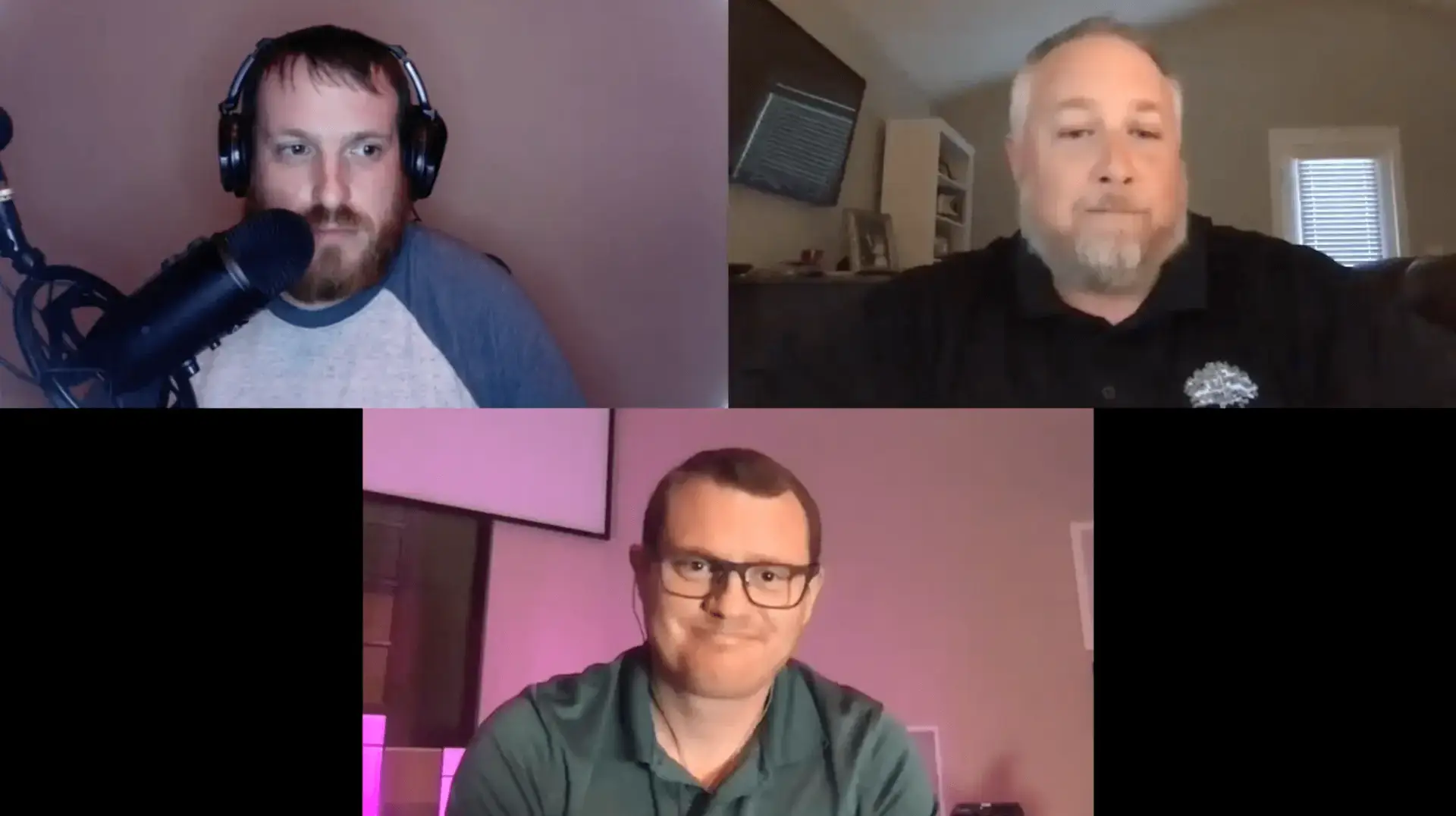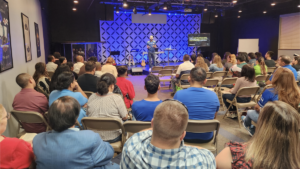Brian Harris
– Hey guys, my name is Brian Harris, I’m with Dogwood Media and we are contracted by the State Board of Missions to help with web and social media. We got the question from churches who are just wanting to get started and get on live stream. So I brought in two of my friends, they have done this before, I consider them experts, they may not consider themselves that but I wanted them to come in and share what they’ve done in their church. So I have Josh Spivey, who is right here, and then we have Jason Davis. Jason is a volunteer at the church and Josh is the Minister of music. And so first I’m gonna get them to explain what’s the new normal for Thorington Road Baptist right now, and what you guys are doing. So, one of you wanna hop in there and explain what you’re doing right now?
Josh Spivey
– Yeah, so obviously, like most churches, this hit us really hard. The reality is we’re not seeing our church members so what has been optional before is now a necessity for us. So, we’re having to do what many other churches are doing live stream to our congregation. We’re kind of ahead of times that being that we were doing it before all this hit. So had an advantage but there have been some things that we’ve learned to do since all this has happened; some things that we’ve realized that we need to do better at and some things that we can add to what we’ve been doing.
Brian Harris
– Right now you guys are streaming on multiple platforms, and I explained like your setup, Jason. Jason is the guy who’s running it every week. So Jason, do you mind explaining what you have set up right now and all the platforms are going to?
Jason Davis
– Yeah, so now, we live stream on a Sunday morning. We actually just run it through Vimeo and then we have Vimeo push it to Facebook. But because of everything going on now we actually have, we load everything into Facebook, into Vimeo and into YouTube and have a premiere, so that everything just comes live at one point and then the whole congregation can watch it as one. And then if they want to watch it later they can watch it later.
Brian Harris
– Now camera-wise you’re using a three camera setup. Most churches that are just getting started are not gonna use a three-camera setup. But explain your cameras and your switcher that you’re using there.
Jason Davis
– Okay, so with our cameras, we have just three, they’re SemiPro 4K cameras, the Panasonic’s. We have one usually set up on either side of our tech booth and one in the middle of the tech booth to give us multiple angles, Our switchers, we’re using a Blackmagic switch right now. Everything runs into that, and then we can put in from our sanctuary max so our words can show up on our stream. We throw in digital signage, so our announcements come in, but everything comes straight into that room. And then we can route any video that we want to anywhere else in the church. So we actually produce everything into that room and we can put our service on the TVs that we have throughout the church, or even into an overflow room that we have set up.
Brian Harris
– Right now I would say Thorington Road is probably going to run about 250 on Sunday mornings. It’s pretty much ahead, I would say, of a lot of churches in their technology or because of what y’all were doing beforehand. But what you’re doing, I feel like some smaller churches could probably learn from that. You mentioned the cameras are doing a three-camera, if you’re a small church, you do one camera, where would you wanna put that one camera at just for that, I mean, just starting from that basic there?
Jason Davis
– I would always just do a wide shot of the stage toward the middle of the sanctuary or auditorium. That way you’re getting the broadest view of what’s going on on stage. And you don’t have to have anybody that can track it if you don’t have a volunteer for it. So just sits it there. If you have somebody that can volunteer, then you can zoom in and move the camera back and forth between whoever’s leading worship or who’s ever praying, and then your pastor as it is.
Brian Harris
– Okay. And also, if you’re starting, let’s go back from that to the camera, you’re not gonna necessarily run a switcher, if you’re just starting this Sunday. If you’re trying to get something out for this Sunday service, you got that one camera, you’re putting it onto a file. We talked about audio beforehand a little bit so let’s dip into that a little bit, because if you have multiple sources on the stage, maybe you have, I’m assuming most small churches have a soundboard in some way of recording that. Josh, you mind jumping into the audio part. I know you’re one that’s re-mixing your audio right now. These churches may not be able to do that.
Josh Spivey
– So audio can be as simple or as complicated as you want it to be. And it is so underestimated when you talk about streaming. And it is so important, but it’s something that nobody ever thinks about. And besides visually, it’s the second most important thing and so, you can have as basic of a setup as grabbing the audio from the camera, if you can do that and you can have a something as complicated as grabbing a mix from the soundboard or post editing, and that’s a whole nother field of view there.
Brian Harris
– So right now, we’re a small church this Sunday we have a camcorder. We have the ability to record, Jason’s got this, he’s given us directions on our shot versus if we have someone to operate it versus not. We’ve gotten that recording, let’s say we do have a soundboard, and we were able to get an audio input it into the camcorder. Worst case, we have a microphone on the front of the camcorder recording the house sound. Do we even try music or do we just go for the message or what do y’all think?
Josh Spivey
– I think it really depends on your church. It depends on your licensing. What your church licensing will allow you to do, a lot of them are a little bit relaxed right now. But it goes back to what can you legally do? But also, yeah, but you hit it Brian, what can your camera do? Cameras, I think in the early 2000s, a lot of them used to have simple little mic jacks, but they’ve gone away from them right now. So you have to have a pretty high end camera to even have a mic jack on it. So I mean, that’s a complication and then how do you get them next to the camera if you do, but if your camera doesn’t have a mic jack, you have to have a converter that would allow you to input audio, so…
Brian Harris
– Some people could even be using their iPad or their iPhone, possibly even as their camera, which then brings another complexity into it. Now would you wanna go back and touch on one thing you talked about with the licensing. You mentioned that sometimes the licensing are being relaxed right now, I don’t know if that’s enough across the board suggestion by any means, that we’d wanna make. I would suggest going and paying for the licenses. Do you have any information on that or directions what needs to go there?
Josh Spivey
– Yeah, we use CCLI, song select, most music guys would would recognize it as SongSelect. But CCLI licensing, there are several licensing levels that you can get and one of them is online streaming.
Jason Davis
– It would go to tell ’em that your stream can still get pulled even if you have the license. If you’re using any type of music, Facebook, YouTube, they don’t recognize that you have a license even if you’ve paid for it, there’s no way to input that. So your stream could get pulled on that. And I’ll go ahead and mention this while I’m talking, if you’re using ambient sound, which is the sound that’s coming from your iPad, your camcorder or anything like that, you wanna be cautious of where you’re putting that camera because it’s happened in a couple churches where stuff that shouldn’t be heard has been heard on livestream. You’re talking about other church members, just talking about stuff that’s going on in the community. So you want to be cautious of where you’re putting this so that that type of stuff doesn’t go out. Just ’cause you don’t have any control of what people are talking about, and you don’t know when somebody’s gonna be talking about that type of stuff.
Brian Harris
– Ouch! So, we’ve got our camera, we’ve talked about our sound and now we’ve got our licensing. So let’s assume that we’ve chosen to do a wide shot and do some movement. We’ve recorded it, now we’ve gotta get it onto our computer ’cause at this point we’re assuming we’re not gonna be doing it live on Facebook or anything like that, because we’re trying to just make sure we get all this done ahead of time, so I want to take that assumption out of it. So we’ve got the file, what do we do at this point? What’s our what’s our next step y’all would suggest?
– Jason.
– Well, you Josh usually does all the post-edit for us.
– Simplifies it. We’re basically looking at just chopping the front and the end off of it and we’re not even looking at graphics or anything like that.
Jason Davis
– So most the time you can run into, if you’re running a Windows machine, if you’re running iMac, or a Macintosh machine, there are entry level editing software systems. I think Windows is still using moviemaker, or something equivalent. And the Macs are using what they call on iMovie. So you just pull your SD card out, connect it to your computer, drop it over there, and then you’ll be able to go in and cut and paste whatever you wanna do. If you decide that you don’t wanna have the worship service in there, you can cut that worship service out but just as the sermon in there.
Josh Spivey
– Yeah. And there are multiple softwares available to do this. But yeah, the post-edit is about mainly trimming out stuff that you don’t want.
Brian Harris
– You’re not talking about trying to overwrite it or anything like that. We’re just looking at getting it to the point where the service starts and where it ends and giving a clean transition on either end. We’re not trying to over-complicate this for, especially for new church, and this is our first time. And most editing softwares, I know this from experience, if you do a Google search, you pretty much can find “How to trim”. And it should be pretty self explanatory. And then most will have an icon that looks like a pair of scissors. And so they try to make it as easy as possible for someone to find the start point, the end point, then using the scissors to trim off the excess film, and then exporting it out. I normally tell people to go as an mp4, especially on an apple machine, I’m not sure what the video file would be on a Windows machine anymore. Y’all think about that one, I’m not sure what–
– MOV?
– Just do MOV on those is what you said?
– Think so.
– Yeah.
– There should be a standard one that should say for web ready-type processes if you’re on a Windows machine, the smallest file type is normally but the one that doesn’t sacrifice quality the same time. So I know typically what we look forward to the words HD or something that says 1920 by 1080 or 720p or something like that, we wanna find something in that quality range that you can export it out of whatever program you use. And then Jason, you mentioned some of the platforms that Thorington Road is using right now with Facebook and Vimeo and YouTube, and y’all are streaming straight from Vimeo to Facebook, which is a paid option, if I remember correctly. I wanna say it’s less than $100 a month for that. But a lot of churches I know they’re probably looking for a free option, which YouTube would be that. It’s pretty simple to upload them. Josh, are you the one uploading those every week right now or…
– I am. Yep.
– So any suggestions on that?
Josh Spivey
– We create a redundancy here ’cause, especially with the first week, we were heavily streaming, I knew that it would probably be an issue with Facebook or some platform going down and that is exactly what happened, Brian. I think you caught it too.
– Yeah.
– So we’ve developed a redundancy where we use Facebook, YouTube, and Vimeo. And so if one fails, the church members can hop on another site. Like I said, Facebook just totally failed us the first week, and so we directed most of our members to YouTube. But yeah, as far as replacing videos, Vimeo is our main video, I guess, hub that we typically use. The beauty of that is we can live stream to it but then later on I can give it a post-edit, and removed all the live video and go to a post-edited replacement. And it won’t change any links for everybody. You can’t do that with a Facebook or YouTube.
Brian Harris
– I know that first week, I was telling everyone personally, I was like, “Hey, go use Facebook Premiere. Don’t worry about doing a live, you need to have some time to get your editing done ahead of time, and then do the premiere.” Then we learned that Facebook was streaming actually from the same server as if it was live. was basically we were losing all the benefit of doing that. And so what you mentioned before about having them redundancies by finding other platforms, so if you do use Facebook, going ahead and putting your video there, but also putting it on YouTube or Vimeo or some other option at the same time, because I know about my family on, this past Sunday morning, we watched the service on Vimeo and because Josh put the video up early and we chose to make our own early service and we had our service ahead of time, before everyone else was watching the premiere on YouTube or Facebook which is a very cool function is that you can put it out there on Facebook or YouTube and use a premiere basically to the set a time when this videos will come available. That function is not available on Vimeo though, is it?
Josh Spivey
– That’s what I was fixing to say, why it can be, I don’t know, I wish it was but we cannot do that. So vimeo’s strictly going to be on-demand or actually live streaming.
Brian Harris
– I know another church used Facebook and I’ve actually seen a couple churches do this now, instead of using the premiere function or even the live, they’re just uploading the video and putting it out there eight o’clock on Sunday morning, and just letting people watch it when they can. And they’ve even encouraged people to use the Watch Party function that’s part of Facebook where if you go watch a video in the bottom right hand corner, it will say “Start a Watch Party, and “invite your friends” and they’ll invite people to come join ’em in watching the live video there and be able to converse within that too. So there’s all kinds of different methods. Facebook, and especially if the church already has a Facebook page, it’s a logical choices because the notifications are gonna go out to the people already subscribed to that. That’s what I’ve always tell people to use those free ones, YouTube is free, Vimeo is gonna be the paid option but it’s also gonna be the higher quality video option. And you’re not going to deal with the ads that you’re gonna see on YouTube or possibly even Facebook even though I haven’t seen–
Josh Spivey
– And that’s why we still consider Vimeo our primary port of exporting videos, it’s the cleanest, no ads. So that’s why it’s still considered my favorite.
Brian Harris
– I haven’t seen any ads on Facebook ads yet, but, I mean, we’re always gonna be the product on Facebook, whatever you’re producing because we’re not paying a fee for it. And so eventually they are going to monetize it. So for that reason alone, I agree with you, Vimeo is probably one of the worthwhile expenses in this whole thing, to be able to have a high quality video and have it out there too.
Jason Davis
– It goes to know too when you pay for Vimeo, there’s a live stream service through them, a software called Live Stream Studio that’s a really good software we started using here in the past, I think three months. OBS is a free software, which is what we started using. But that Live Stream Studio lets us do a little bit more and goes ahead and pushes everything out for us so we don’t have to put any codes in or anything like that, it’s just straight there. So that’s another benefit for having Vimeo.
Brian Harris
– Okay, well, I feel like we’ve touched in all the basics that the church will need to start a livestream for this Sunday, from the who to put them, I mean, over the platform, we’re looking at using your basic musicians, but depending on your sound abilities, your input into your camera, the camera choice is going to depend on what you have available. Worst case scenario, I feel like you’re gonna find someone that has a nice iPhone in your congregation that can help video it at the worst case scenario. Most likely, you may already have a camcorder or someone else has one that they could use to do that. If you have multiple camcorders, and you have to look into a switcher option, which right now might be a little difficult for starting this Sunday, but the three of us were having a text conversation about a new one that Blackmagic just put out that would be a great solution for a lot of churches–
– Inexpensive.
– I think it’s less than $300, wasn’t it? I think it’s five, maybe.
– Yeah, yeah.
– I think five is for the one that has live streaming, I think built into it. And the one that doesn’t have live streaming built in that was close to 300.
Josh Spivey
– ‘Cause here’s the big thing too, you’re gonna need a way to get it into your computer. And so some devices are gonna be better for that than others so you gotta get it to your computer somehow.
Brian Harris
– At that low cost Blackmagic switcher was, I think it’s all HDMI, and most cameras will have an HDMI output on the back of it, most of your computers have HDMI. So if you’re trying to get into a little bit higher level, I think there’s even audio inputs on that one, that’s the 599 version. There is.
– There is.
– You can pick an audio feed off your soundboard and have a four input switcher between three cameras and a computer and have a really top-notch looking presentation for a very low cost amount and then taking advantage of your free options on getting it out with the Facebook and YouTube and then for the higher quality using Vimeo. So I feel like we’ve hit–
Josh Spivey
– To me if I had nothing, that’s what I would do.
Brian Harris
– Is use a camcorder, go for the 599 Blackmagic switcher.
– Yep.
– You basically can get a live streaming, how much does a camcorder cost, a good camcorder that you would put in a church right now?
– You know, that’s, Jason.
Jason Davis
– Well, the ones we’re using now I think we spent like 700 on. Even before then though the Panasonic’s that we were using were just little handicams–
– We bought at Costco. Yeah, I think worth $200?
– On sale.
– And we were still getting great pictures there, 4K. And it should be noted Facebook doesn’t do 4K, the highest they stream right now is I think 1080p, so you don’t need a 4K camera to do any of this and Blackmagic their stuff doesn’t support 4K on the lower end. I think once you get to the higher end stuff, you’ve spent some money it will support the 4K. But, go out get you a $200 camera from Walmart, from Target, Costco. You can even get a DSLR now and have a really nice lens on it and get you a really good stream from that, Canon, all that.
– A lot of people have DSLRs.
– Yeah, Blackmagic, we’ve talked a lot about Blackmagic, they are really the best when it comes to price range and quality. Their cameras if you look them up, they’re usually compared to the RED cameras. RED cameras are what Peter Jackson used for “The Hobbit” movies. I mean, they are $20,000 cameras just for the body not including lenses and stuff like that. So you’re getting the same quality off these Blackmagics as you are on these REDs. So I think the lowest end one is $1,000 so it’s really not a bad price for a body when you’re looking at stuff.
Brian Harris
– Realistically, a church starting a live stream if they want to make an investment in a nice switcher, they can get one for $600, a Blackmagic switcher, they could buy three cameras, three camcorders for as low as $200 to $300 apiece, and then you got some wiring and stuff like that you got to put in between you, assuming you already have a soundboard and getting the sound out of that. And then that particular one records to your computer, if I remember correctly, I believe it hooks up to the computer and you could export your video out of it. Worst case scenario, there are some recording devices that Blackmagic sells that are, I think, want to start off, around the $500 range too. So you get a full setup, assuming you may already have a TV around as HDTV that you can use as a monitor, switcher, recording, two cameras, under $2,000 would get you to you would look professional, super professional.
Josh Spivey
– Yeah, so we’ve kinda prided ourselves here at our church based upon doing things for very low cost. And I’ve read several articles about a basic setup, 10 grand, and I laugh at it. Because that’s insane.
– That’s not realistic, for most part.
– No, it’s not. It’s not realistic as far as what I can do for $2,000 and it’s not realistic based on what most churches can do if they don’t have anything right now.
Brian Harris
– And all these things are very volunteer friendly. I mean, Jason, did you have any training before you came into the church in doing video editing and stuff or doing directing or any of this wiring and running all these things? Or was this may be you learned most of it at Thorington Road?
Jason Davis
– It was, a lot of it, was hobby. The live stream stuff was very much new to me. Josh has been great for being patient with me in learning stuff. And this time what we’re working with now, Josh has been really great at just letting go with it and directing the way that I think something should look and getting my input on stuff and just let me go. So if you’re starting a live stream, just find somebody that has the passion for video, for editing and stuff like that, that has an eye for it. And just let them have fun, trust them in what they’re doing ’cause you could have the next, really big nice stream or you could end up just having a basic stream that can get out there. But it really helps your ministry and it helps somebody else in another place to get into a spot where they feel needed and they feel wanted, that they can use their talents for the Lord.
Brian Harris
– Cool, I think we’ll end on that, I think we were able to, hopefully, a church will be able to watch this and be able to have the tools to get them started for a small church and then as they grow, hopefully, they can even look at the different ways they could use these tools we gave ’emm just today, just to grow the ministry and how easy it can be done. And hopefully, and not an expensive thing because we wanna be good stewards of the money we’ve been given. I think Thorington Road is a great example of that, being able to take a little bit and make a lot of it and they’re seeing a lot of people every week watching those videos right now that they’re doing and they’re putting a lot of thought into each one that they’re doing. And I think that’s one thing we never really touched on is the planning part of it and making sure that you’re planning out the service ahead of time and not just going in. Because it’s livestream service, is a little bit different than a live service. Because you’re pre recording it, you’re able to go in and think ahead of all the different elements. I guess… I’m almost done, but I maybe think of it–
– You’re having a good point.
– Josh to go back in and think about how your service should be different for live stream.
Josh Spivey
– So let me give you an example of the benefit of pre recording. So we recorded Michael, our pastor on Thursday, and this was before, I believe, the governor’s address where she tightened everything down. Well, Michael, during this announcement time had already mentioned two announcements that were not valid anymore, pass that order. I was easily able to edit it out, and we didn’t have to come back up here to re-shoot. Now, in the live setting, I guess you could argue that he would have canceled those out himself but yeah, there are things that you might not even see in the live setting that you want not in the live stream.
Brian Harris
– I’ve noticed you’ve even changed your stage setup just because right now you don’t have a choir, so you took all the choir chairs out and used the opportunity to use that space behind you–
Josh Spivey
– Yeah, yeah, we replaced them with panels, the choir with panels, but–
– low cost panels.
– Very low costs, yes. Some of these panels are some, Brian, what do you call this material, the A frame material?
– Oh, the coroplast.
– Yeah, those are simply coroplast signs with gaffer’s tape. But we knew that we needed to do some things to change it up every week and so more of a set design mentality was my means of trying to change things up.
Brian Harris
– And that’s not a normal thing at that Thorington Road, you’re not normally doing a set design. Normally your choir’s back there, your stage is pretty much just basically the same thing every week. So you’ve looked at this as like, “Hey, we need to do something different for online “because right now there no people here–
Josh Spivey
– Yeah, and we might learn some things moving ahead from this, it’s definitely given me some more ideas of hey, what can we do to change things up when everybody does come back? I’m not saying I’m gonna remove the choir.
– Be careful, right? Be careful.
– Yeah, but there are some things from a design perspective that we could do to spruce our sanctuary up.
Brian Harris
– I even noticed that you use a monitor for when Michael’s preaching, he has his points there instead of having to go back and forth, you’re able to set the points on the monitor there and even the lyrics during the worship time, y’all started doing a lower third with that, which y’all don’t normally do that when it’s a normal live stream, ’cause you’re wanting people to come, whereas not now, there’s not even a choice to come. So you’re having to adapt basically, to meet the need.
Jason Davis
– We do used to do lower thirds on Livestream but it we’ve had some complications with the software–
Josh Spivey
– We’re limited by technology at the moment, but we’re just looking at it a different way. I’m doing all the lyrics post-edited in the video software as opposed to trying to do them lower thirds live.
– It goes to say too is if you’re doing anything post-edit with words, make sure you spell check.
– Very much.
– There’s a story there.
– The pastor comes after you.
– I feel like there’s a story there, for sure. Yeah.
Jason Davis
– Josh misspelled some stuff, in the first week, I think, Michael said or something.
Brian Harris
– Everyone sees it now too, is not like the live stream where you had, maybe it’s averaged about 10 people a week and now you’re seeing–
Josh Spivey
– Now it matters, it’s not that it didn’t matter before, but it really matters now.
Brian Harris
– Everyone could hit pause and do screenshots now and send it back to just so they can, just shows your errors over and over again.
Josh Spivey
– And an awkward expression is inevitable if you pause it in the right place.
– Yes.
Jason Davis
– So I’ma just say though, I wanna touch on a little bit with numbers, with watching. Obviously we’re in different times right now. Our live stream usually it was about 10 people, Max, I think, five to 10 people. When everything goes back to normal, don’t get discouraged by the low numbers. Those people that shut ins, those people who are on vacation, and stuff like that, that want to reach out. We have one lady who watches every Sunday, she makes sure she tells us that she’s here. She tells us “Hi.” When she met Josh, Josh was the celebrity because of seeing him on–
Josh Spivey
– She’s always seeing me on screen.
Jason Davis
– So I mean, those five people that are watching your service is important to ’em, you’re reaching ’em, they feel part of the church too. So right now you might be getting 30 to 50, 100, who knows how many views during your streams, during your your videos. But when it goes back to normal, don’t look at those numbers again. Those those numbers are not important. You’re still getting out there, you’re doing what God needs you to do and giving that word to the person who needs to hear it.
Josh Spivey
– Yeah, I know we need to close up but let me say this, the power of live streaming video I guess in our church, I don’t know the lady. A lot of our church members do know her. She was apparently involved when our church was Woodley back in the day and she just gotten out of church and we actually shared a testimony a few weeks ago, and it just hit her really hard. Like, she literally stopped dead in her tracks and it touched her, like, I think life changing and had we have not have had this ministry, we would not have gotten that to her. And so, hopefully we’re changing lives by this, I pray we are. And so, yeah, just getting our message out.
Brian Harris
– Well, this Coronavirus is gonna make everyone look at different things they might not have considered before. And maybe that ends up being the, maybe it’s not something necessarily we wanted to do but now because we have to do this, again is that reaching other people that you may never been able to reach before. So, I mean, God could definitely use this, even during this time, to help connect people because there’s a lot of people that they’re really lonely right now. And this serves as a way for them to be able to connect and if your church is not doing this or if your church is not having anything right now or maybe even the rule changes that just came out where maybe you met because you’re underneath the numbers, but now you can’t do that, this is a really simple way to be able to connect with members and be able to use the tools you have or to be able to spend small amounts of money to be able to improve it and do even better things and bigger things. I mean Thorington Road didn’t start with three cameras on day one. It started small and it grew from there. It grew fast, I will say, because there was a need and because volunteers were able to buy in and as a way for people to do it. So basically I hope all these tools will be able to help some small churches. I wanna thank Josh and Jason for jumping on here today and hopefully providing some good insights so everyone will enjoy and be able to see and use. If you have any questions, we’d love to help you. Alsbom, A-L-S-B-O-M .org is the website. You wanna go there and be able to look at the Coronavirus page, the link is on the homepage right now, you’ll find all kinds of resources there. There’s a listing of all the state missionaries, you can click on that and have all their contact information to be able to contact them, get any kind of resources from them that they can help you with, they wanna help you. That’s what the state missionaries are there for, that’s the money that you give through the Cooperate Program. That’s what it goes to fund is these the things like right now, what we’re doing are Cooperate Program funded, and so we wanna be a resource for you. So thanks for tuning in today. Thanks guys for joining me.
Thank you, Brian.
Thank you.






